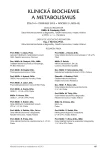Trace elements in critical states. Part 1: zinc and iron
Authors:
A. Kazda; H. Brodská
Authors‘ workplace:
Ústav lékařské biochemie a laboratorní diagnostiky 1. LF UK a VFN Praha
Published in:
Klin. Biochem. Metab., 21 (42), 2013, No. 4, p. 197-202
Overview
The problems of trace elements (TE) metabolism and of their supplementation in critically ill patients are different from metabolism and optimal daily intake under physiological conditions or during less dangerous diseases. Critically ill patients may to lose unmeasurable amount of these elements by gastric suction, by drain or fistula content, by bleeding or blood sampling. On the other side they receive unmeasurable amounts of TE thanks to contamination of infusions, solutions of parenteral nutrition or through the transfusions or supplementation of albumin. TE have the key significance for the alleviation of the oxidative stress. With regard to critical states most often are discussed zinc, iron, copper and selenium.
Part 1. of our paper is dedicated to zinc and iron. Thanks to interleukins, in reaction to trauma and infection these TE are redistributed from plasma into tissues. This is comprehended as efforts to eliminate from the circulation elements supporting the microbial growth. With respect to the significance of zinc for the synthesis of proteins and of iron for the erythropoiesis more clinical trials were realized with supplementation of these TE in higher amounts as generally recommended. Nevertheless till today the experimental, as well as clinical, studies and reviews are often finished with warning before high dosing in critical states.
In the paper are also discussed the complications of abundant intake of both TE. The toxic effects of zinc and iron overdose, which can cause a critical condition per se, are mentioned.
Keywords:
zinc, iron, trauma, systemic inflammation, critical state.
Sources
1. Hardy, Y. G., Mendenez, A. M., Pharm, B. et al. Trace element supplementation in parenteral nutrition: Pharmacy, posology, and monitoring guidance. Nutrition, 2009, 25, p. 1073-1084.
2. Berger, M. M., Cavadini, C., Chiolero, R., et al. Copper, selenium, and zinc status and balances after major trauma. J Trauma Injury Infection Crit. Care, 1996, 40 (1), p. 103-109
3. Braunschweig, C. L. Parenteral zinc supplementation in human adults during the acute phase response. J Nutr., 1997, 127 (7), p. 70-74.
4. Heyland, D. K., Jones, N., Cvijanovich, N. Z. et al. Zinc supplementation in critically ill patients: a key pharmaconutrient? J Parent. Enter. Nutr., 2008, 32 (5), p. 509-519.
5. Duncan, A., Dean, P., Simm, M., et al. Zinc supplementation in intensive care: results of a UK survey. J Crit. Care, 2012(27), p. 102.e1-102.e6.
6. Kazda, A., Dvořáková, S., Štěpánová, I. et al. Sledování hodnot zinku u chirurgických nemocných. Čas. lék. čes., 1976, 115(18), p. 543-548.
7. Kazda, A., Brodská, H., Valenta, J. Problematika a sledování suplementace zinku a selenu v intenzivní péči. Klin. bioch. metab., 2004, 3, p.184-189.
8. Cvianovich, N. Z., King, J. C., Flori, H. R. et al. Zinc homeostasis in pediatric critical illness. Pediatr. Crit. Care Med., 2009, 10 (1), p. 29-34.
9. Shenkin, A. Trace elements and vitamins in parenteral and enteral nutrition. In: Sobotka, L. (ed.). Basics in clinical nutrition, Praha: Galén, 2000, p. 62-71.
10. Shenkin, A. Micronutrients. Physiologic function and deficiency states of trace elements. In Sobotka, L. (ed.). Basics in clinical nutrition, Praha: Galén, 2011, p. 53-59. a 140-145.
11. Moeschlin, S. Vergiftungen durch anorganische Stoffe. In Moeschlin, S.et al. Vergiftungen. Stuttgart: Thieme 1986, p. 181-182.
12. Vávrová, J., Pechová, A., Wilhelm, Z. et al. Vitaminy a stopové prvky. Pardubice: ČLS JEP a SEKK 2007, 156 s.
13. Kazda, A. Mikronutrienty. In Kazda, A. et al. Kritické stavy, metabolická a laboratorní problematika. Praha: Galén 2012, p. 81-118.
14. Piagnerelli, M., Vincent J.-L. The use of erythropoiesis-stimulating agents in the intensive care unit. Crit. Care Clin., 2012, 28, p. 345-362.
15. Vyoral, D., Petrák, J. Hepcidin: a direct link between iron metabolism and immunity. Intern. J Bioch. Cell Biol., 2005, 37, p. 1768-1733.
16. Hoen, B., Paul-Dauphin, A., Kessler, M. Intravenous iron administration does not significantly increase the risk of bacteremia in chronic hemodialysis patients. Clin. Nephrol., 2002, 57, p. 457-461.
17. Simonse, E., Valk-Swinkels, C. G. H., vant´t Veer, N. E. et al. Iron autointoxication in a 16-year-old girl. Ann. Clin. Biochem., 2013, 50, p. 76-79.
18. Swoboda, S. M., Lipsett, P. A. Intravenous iron as a risk factor for bacteremia in the surgical intensive care unit patient. Surg. Infect. (Larchmt.), 2005, 6, p. 158.
19. Torres, S., Kuo, Y. H., Morris, K. et al. Intravenous iron following cardiac surgery does not increase infection rate. Surg. Infect. (Larchmt.), 2006, 7, p. 361-366.
20. Hayden, S. J., Albert, T. J., Watkins, T. R. et al. Anemia in critical illness. Am. J. Respir. Crit. Care Med., 2012, 10 (185), p. 1049-1057.
21. Garrido-Martín, P., Nassar-Nansur, M. I., de le Llana-Cucrós, R., et al. The effect of intravenous and oral iron administration on perioperative anaemia and transfusion requirements in patients undergoing elective cardiac surgery: a randomized clinical trial. Interactive CardioVascular and Thoracic Surg., 2012, 15, p. 1013-1018.
22. Chang, T. P., Rangan, C. Iron poisioning: a literature – based review of epidemiology, diagnosis and management. Pediatr. Emerg. Care, 2011, 27, p. 978 – 985.
Labels
Clinical biochemistry Nuclear medicine Nutritive therapistArticle was published in
Clinical Biochemistry and Metabolism

2013 Issue 4
Most read in this issue
- Haemolysis influence on the determination of total and direct bilirubin
- Cerebrospinal fluid analysis in the diagnosis of subarachnoid hemorrhage
- Trace elements in critical states. Part 1: zinc and iron
- Trace elements in critical states. Part 2: copper and selenium
